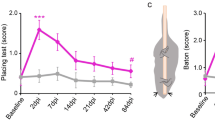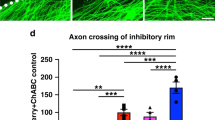Summary
In the adult mammal, nerve fibres do not regrow into the spinal cord after a dorsal root lesion. The elongation of dorsal root nerve fibres into the spinal cord of neonatal rats was examined: L4 and L5 dorsal roots were crushed in rat pups. After 3–6 months, the dorsal root-spinal cord junction was investigated morphologically in several long series of ultrathin cross-sections. In rats which had been operated on at birth (0–2 days old), axons from the lesioned roots could be followed into the CNS tissue of the spinal cord. In contrast to normal development, the usual short segment of CNS glia did not grow into the neonatally lesioned roots. Instead, the CNS-PNS border was located within the spinal cord. The nerve fibres, which were of normal diameter, had regrown across the PNS-CNS border and elongated further into the CNS environment of the spinal cord. In rats operated on at the end of the first postnatal week or later, the largest dorsal root nerve fibres were only half the size of those in unoperated animals and reinnervation of the spinal cord had not occurred. An astrocyte-dominated CNS segment had developed in these roots. The impact of an early neuronal lesion on the development of certain glia cells and their importance in the outcome of spinal cord reinnervation are discussed.
Similar content being viewed by others
References
Aguayo, A., David, S., Richardson, P. &Bray, G. (1982) Axonal elongation in peripheral and central nervous system transplants. InAdvances in Celluar Neurobiology, Vol. 3. (edited byFedoroff, S. &Hertz, L.), pp. 215–34. New York: Academic Press.
Berthold, C-H. &Carlstedt, T.(1977a) Observations on the morphology at the transition between the peripheral and the central nervous system in the cat. II. General organization of the transitional region in S1 dorsal rootlets.Acta Physiologica Scandinavica Suppl. 446, 23–42.
Berthold, C-H. &Carlstedt, T.(1977b). Observations on the morphology at the transition between the peripheral and the central nervous system in the cat. III. Myelinated fibres in the S1 dorsal rootlets.Acta Physiologica Scandinavica Suppl. 446, 43–60.
Berthold, C-H., Carlstedt, T. &Corneliusson, O. (1984) Anatomy of the nerve root at the centralperipheral transitional region. InPeripheral Neuropathy, (edited byDyck, P. J., Thomas, P. K., Lampert, E. H. &Bunge, R. P.) Vol. 1 2nd edn, pp. 156–70. Philadelphia: Saunders.
Blakemore, W. F. (1975) Remyelination by Schwann cells of axons demyelinated by interspinal injections of 6-aminonicotinamide.Journal of Neurocytology 4, 745–57.
Blakemore, W. F. (1976) Invasion of Schwann cells into the spinal cord of the rat following local injections of lysolecitin.Journal of Neuropathology and Applied Neurobiology 2, 21–39.
Blakemore, W. F. &Patterson, R. C. (1975) Observations on the interactions of Schwann cells and astrocytes following X-irratiation of the neonatal rat spinal cord.Journal of Neurocytology 4, 573–83.
Carlstedt, T. (1977) Observations on the morphology at the transition between the peripheral and the central nervous system in the cat. I. A preparative procedure useful for electron microscopy of the lumbosacral dorsal rootlets.Acta Physiologica Scandinavica Suppl. 446, 5–22.
Carlstedt, T. (1981) An electron-microscopical study of the developing transitional region in feline S1 dorsal rootlets.Journal of the Neurological Sciences 50, 357–72.
Carlstedt, T. (1983) Regrowth of anastomosed ventral root nerve fibres in the dorsal root of rats.Brain Research 272, 162–5.
Carlstedt, T. (1985a) Regrowth of cholinergic and catecholaminergic neurons along a peripheral and central nervous pathway.Neuroscience 15, 507–18.
Carlstedt, T. (1985b) Regenerating axons form nerve terminals at astrocytes.Brain Research 347, 188–91.
Carlstedt, T. (1985c) Dorsal root innervation of spinal cord neurons after dorsal root implantation into the spinal cord of adult rats.Neuroscience Letters 55, 343–8.
Carlstedt, T., Dalsgaard, C-J. &Molander, C. (1987) Regrowth of lesioned dorsal root nerve fibres into the spinal cord of neonatal rats.Neuroscience Letters 74, 14–8.
David, S., Miller, R. H., Patel, R. &Raff, M. C. (1984) Effects of neonatal transection on glial cell development in the rat optic nerve: Evidence that the oligodendrocyte-type astrocyte cell lineage depends on axons for its survival.Journal of Neurocytology 13, 961–74.
Eidelberg, F. &Stein, D. C. (1974) Functional recovery after lesion of the nervous system.Neuroscience Research Program Bulletin 12, 191–303.
Gilbert, M. &Stelzner, D. J. (1979) The development of descending and dorsal root conections in the lumbosacral spinal cord of the postnatal rat.Journal of Comparative Neurology 184, 821–38.
Goldberg, S. &Frank, B. (1981) Do young axons regenerate better than old axons?Experimental Neurology 74, 245–59.
Hulsebosch, C. E., Coggeshall, R. E. &Chung, K. (1986) Numbers of rat dorsal root axons and ganglion cells during postnatal development.Developmental Brain Research 26, 105–13.
Kalil, K. &Reh, T. (1979) Regrowth of severed axons in the neonatal central nervous system: Establishment of normal connections.Science 205, 1158–61.
Kerr, F. W. L. (1976) Segmental circuitry and spinal cord nociceptive mechanisms. InAdvances in Pain Research and Therapy, Vol. 1, (edited byBonica, J. J. &Albe-Fessard, D.) pp. 75–89. New York: Raven Press.
Levitt, P. M. C. &Rakic, P. (1980) Immunoperoxidase localization of glial fibrillary acidic protein in radial cells and astrocytes of the developing rhesus monkey brain.Journal of Comparative Neurology 193, 815–40.
Lindå, H., Risling, M. &Cullheim, S. (1985) ‘Dendraxons’ in regenerating motoneurons in the cat: Do dendrites generate new axons after central axotomy?Brain Research 358, 329–33.
Liu, C. N. &Chambers, M. (1958) Intraspinal sprouting of dorsal root axons.Archives of Neurology and Psychiatry 79, 46–61.
Mira., J-C. (1980) Contribution a l'etude de la regeneration du nerf peripherique et des changements du muscle squelettique strié au cour de sa reinnervation.These a l'université Pierre et Marie Curie. Paris.
Peters, A., Palay, S. &Webster, H. De F. (1976)The fine structure of the Nervous System. Philadelphia: W. B. Saunders.
Perkins, S., Carlstedt, T., Mizuno, K. &Aguayo, A. J. (1980) Failure of regenerating dorsal root axons to regrow into the spinal cord.Canadian Journal of Neurological Science 7, 323.
Risling, M., Cullheim, S. &Hildebrand, C. (1983) Reinnervation of the ventral root L7 from ventral horn neurons following intramedullary axotomy in adult cats.Brain Research 280, 15–23.
Reier, P. J. Stensaas, L. J. &Guth, L. (1983) The astrocytic scar as an impediment to regeneration in the central nervous system. InSpinal Cord Reconstruction (edited byKao, C. C., Bunge, R. P. &Reier, P. J.), pp. 163–195. New York: Raven.
Schneider, G. E. (1973) Early lesions of superior colliculus: Factors affecting the formation of abnormal retinal projections.Brain Behaviour and Evolution 8, 73–109.
Schreyer, D. J. &Jones, E. G. (1983) Growing corticospinal axons by-pass lesions of neonatal rat spinal cord.Neuroscience 9, 31–40.
Seno, N. &Saito, K. (1985) The development of the dorsal root potential and the responsiveness of primary afferent fibres to γ-aminobutyric acid in the spinal cord of rat fetuses.Developmental Brain Research 17, 11–16.
Silver, J. &Shapiro, I. (1981) Axonal guidance during development of the optic nerve: The role of pigmented epithelia and other extrinsic factors.Journal of Comparative Neurology 202, 521–38.
Silver, J., Lorenz, S. E., Wahlsten, D. &Coughlin, I. (1982) Axonal guidance during development of the great cerebral commissures: Descriptive and experimental studies,in vivo, on the role of preformed pathways.Journal of Comparative Neurology 210, 10–19.
Smith, C. L. (1983) The development and postnatal organization of primary afferent projections to the rat thoracic spinal cord.Journal of Comparative Neurology 220, 29–43.
Stein, D. G., Rosen, I. I. &Buffers, N. (1974)Plasticity and Recovery of Function in the Central Nervous System. New York: Academic Press.
Author information
Authors and Affiliations
Rights and permissions
About this article
Cite this article
Carlstedt, T. Reinnervation of the mammalian spinal cord after neonatal dorsal root crush. J Neurocytol 17, 335–350 (1988). https://doi.org/10.1007/BF01187856
Received:
Revised:
Accepted:
Issue Date:
DOI: https://doi.org/10.1007/BF01187856




